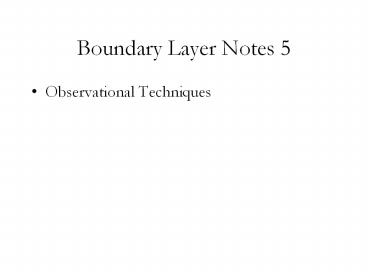Boundary Layer Notes 5 - PowerPoint PPT Presentation
1 / 14
Title:
Boundary Layer Notes 5
Description:
How do sonic anemometers work? Derive speed of sound c = gamma RTv/m ... Sketch sonic anemometer layout, to justify Vd = c2/2d*(t2-t1) ... Sonic Anemometer, cont'd. ... – PowerPoint PPT presentation
Number of Views:118
Avg rating:3.0/5.0
Title: Boundary Layer Notes 5
1
Boundary Layer Notes 5
- Observational Techniques
2
Observational Techniques
- Sources Kaimal Finnegan, Atmospheric Boundary
Layer Flows their structure and measurement,
Oxford University Press, 1994 - In situ techniques
- Important boundary layer measurements
- T, u, v, w, q, trace gases (e.g. CO2, CH4)
3
Observational Techniques
- We need to measure both mean quantities and
fluctuations. - Why fluctuations? After all we can use
flux-gradient relationships to determine fluxes
using mean conditions. Answer because we
dont know if we can trust the flux-gradient
relationships especially in very turbulent,
nearly well-mixed boundary layers.
4
- For means, standard measurement techniques are
acceptable (thermistors, wind vanes,
cup-anemometers, propellers, hygristors,
psychrometer, dew-point hygrometer) - Sketch dew-point hygrometer, psychrometer.
5
- For fluctuations, we need to get more clever.
- Why? Response time. We need independent
measurements every 0.1 s to produce reliable flux
measurements. - Solution sonic anemometers, sonic thermometers,
and TDL (and other radiometric) observations of
trace gases. - How do sonic anemometers work?
- Derive speed of sound c vgamma RTv/m
- Note approximateness of Tv dependence derive (1
0.38e/p) factor. - Sketch sonic anemometer layout, to justify Vd
c2/2d(t2-t1), - (old fashioned measurement, when anemometer only
measures the difference between the times). - Vd d/2(1/t1 1/t2)
- Mast issues have to place instruments far away,
and not down-wind of towers.
6
- Remote sensingfine for mean state of boundary
layer, not for direct flux measurements. - Describe
- radar wind profiles
- Sodar
- Lidar
- Radio Acoustic Sounding System (bouncing radar
off of density gradients caused by sound wave
emissions).(lidar very expensive as of 94
anyway). - Old wind profilers werent useful for boundary
layer studies because their minimum ranges were
1 km. Newer ones at 915 Mhz can measure from
100 m to 1.5 km with 50 m resolution. But
time constant is still a few minutes.
7
Sonic Anemometer
Derive speed of sound
Sketch anemometer layout, and derive
8
Sonic Anemometer, contd.
- We can now make our measurement of the
temperature more accurate, by adding together the
reciprocals of the separate times, and if were
using a three-dimensional sonic anemometer, we
can get t1 and t2 from the vertical anemometer
axis, and Vn from the magnitude of the horizontal
wind.
9
A bunch of sonic anemometers from Applied
Technologies. Data rates range from 10/s to
1/s.f
10
Li-Cor (brand) IR absorbtion Gas Analyzers.
Funny-looking one is an open cell, for
eddy-correlation measurements.
11
(No Transcript)
12
(No Transcript)
13
(No Transcript)
14
(No Transcript)































